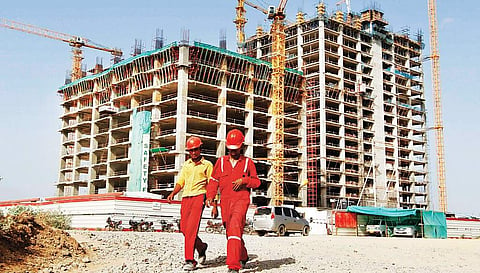

It's official.
India's economy has been reduced from flesh to bone with September quarter GDP growth crashing to a 26-quarter-low of 4.5 per cent. Just a quarter before, it grew at 5 per cent, which now appears respectable than the latest print.
The Central Statistics Office's (CSO) big numerical reveal on Friday also showed that gross value added fell with an intimidating speed to 4.3 per cent, a level last seen way back in 2013. It was in March, 2013 that GDP stood at 4.3 per cent.
With this, the economy has been on a graveyard spiral for seven quarters straight, including three consecutive quarters of sub-6 per cent growth. Now, two most fundamental points - if growth has bottomed out and when recovery will begin - remain up for question.
ALSO READ | Moody's raises concern that slow growth will keep states' deficit high
From a period of prosperity (GDP growth of 7 per cent just 12 months ago) to a period of peril (4.5 per cent now), India's growth has been crashing in devastating style. The dismal Q2 GDP growth gives enough ammunition for the RBI to reduce policy rates next week.
It has already cut repo rate by 135 bps -1.35% - since February. The latest growth print also implies that restoring both India's fastest-growing economy tag and the ballyhooed USD 5-trillion target will be further delayed.
So what went wrong? As it turns out, basically everything.
A reading of October core industries data, released moments before the GDP numbers, showed contraction of 5.8 per cent as against the previous month's 5.2 per cent.
Six of the eight constituents including production of steel, cement, coal and electricity generation all declined in tandem, while fertilizers production grew. Worryingly, during the first seven months of FY20, core industries growth fell to an alarming 0.2 per cent as against 5.4 per cent last year.
Keeping the tradition of raining down dismal data upon us, another data dispatch on Friday showed that India's fiscal deficit in the first seven months through October breached the full year target! At Rs 7.2 lakh crore, the nation's market borrowings stood at a whopping 102.4 per cent of the budgeted target for FY20.
Disappointingly, net tax receipts in April-October stood at a lowly Rs 6.83 lakh crore, while total expenditure was bursting at the seams at Rs 16.55 lakh crore.
Given the bleak tax collections and subdued investment and demand prompted Finance Minister Nirmala Sitharaman to humbly hint at a likely breach in fiscal deficit a few days ago.
Among the eight broad indicators in measuring GDP, six saw a wholesale collapse. Notably, manufacturing that teetered on the edge in June quarter, finally entered the negative terrain clocking a de-growth of 1 per cent.
The sharpest reduction was seen in electricity, and services, which saw a correction of 5 and nearly 3 percentage points correction in Q2 over Q1. Mining, on the other hand, registered a next-to-nothing 0.1 per cent growth, and is now a few notches away from contraction. That said, growth in agriculture and government spending offered a few crumbs of comfort.
In all, GDP in September quarter stood at Rs 35.99 lakh crore as against Rs 34.43 lakh crore the previous year. Gross value added - excluding subsidies and taxes - a better measure of national output stood at Rs 33.16 lakh crore compared to Rs 31.79 lakh crore.